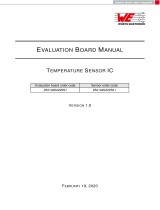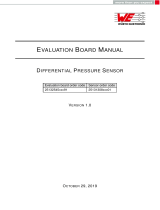
UM10402 All information provided in this document is subject to legal disclaimers. © NXP B.V. 2011. All rights reserved.
User manual Rev. 1 — 1 September 2011 13 of 24
NXP Semiconductors
UM10402
STARplug Triple Output demo board
In the default configuration, the supply for the optocoupler’s LED is derived from the 12 V
output via resistor R19. The supply could also be derived from the 5 V output via resistor
R17. In which case, remove R19 and install R17.
If you want to derive the supply from the 3.3 V, only install resistor R15. However, in this
case, replace IC3 by a 1.25 V voltage reference device. In addition, recalculate the R14,
R16, R18 and R20 feedback resistor values using Equation 3
Equation 4, Equation 5,
Equation 6
, Equation 7 and Equation 8 with V
REG
equal to 1.25 V.
The circuit that corresponds to the alternative (weighed) secondary feedback
implementations is shown in Figure 9
. See Table 6 for the component changes involved.
6.4 Self-supplied TEA152x
The option exists to have the TEA152x SMPS IC generate its own power supply using the
built-in JFET. The advantage is that the auxiliary winding on the transformer T1 is not
required, reducing cost. The disadvantage is that generating the supply voltage using the
built-in JFET causes additional power losses. The high efficiency figures and low standby
figures as shown in Table 3
and Table 4 no-longer apply.
Apart from supplying the V
CC
power for the IC, the transformer’s auxiliary winding also
informs the IC’s AUX pin of the transformer’s magnetization. When the auxiliary winding is
no longer present, an alternative method is needed to inform the AUX pin about the
transformer’s magnetization status. This alternative method is capacitive coupling.
As the hot connections of the respective transformer T1 windings are in phase during
operation, the voltage (or information) appearing on the primary winding’s hot side can be
used to indicate if the transformer is demagnetized. Creating a capacitive coupling
between the “hot” side of the primary winding and the STARplug IC AUX pin enables easy
transfer of the information. Due to the relatively high impedance of the AUX pin, only a
small capacitive coupling is enough. Pull the AUX pin to ground using a high value resistor
(around 500 k). This action guarantees the voltage on the pin is below 100 mV during
start-up.
The capacitor C14* shown in circuit diagram Figure 10
acts as the capacitive coupler
between the transformer’s “hot” side and the STARplug IC AUX pin. A typical value for this
capacitor is 2 pF. The parasitic capacitance that can be created with the layout of the PCB
is generally adequate to give sufficient coupling. There is usually no need to mount the
C14* component. To be formally correct, the ~500 k impedance between the IC AUX pin
and GND is split in two resistor values: R6 and R10. R6 limits the current that can be
injected into the AUX pin through the capacitive coupling (typical value 100 k).
Remark: An overcurrent on the AUX pin can damage the IC!
The combination of R6 and R10 builds the impedance that pulls the AUX pin to ground
during start-up (typical value for R10: 390 k).
When the STARplug IC is self-supplied from the built-in JFET, there is no-longer any use
for Zener diode D3. This is because the VCC voltage never rises that high. In addition, the
protection described in Section 5.5
is no-longer active.
Remark: A defective or strongly degraded optocoupler IC2 results in an uncontrolled rise
of the output voltage(s) in the SMPS!























